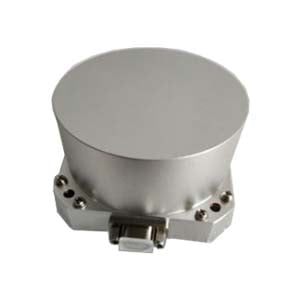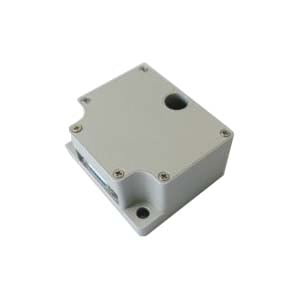1.Accelerometer
Accelerometer (Accelerometer, G-Sensor), also called gravity sensor, can actually sense the acceleration in any direction (the acceleration of gravity is only the acceleration in the vertical direction of the surface), and the accelerometer measures the force of the component in a certain axis. To get the result, the form is the acceleration magnitude and direction (XYZ) of the axial direction, which is similar to the gyroscope, but the gyroscope pays more attention to its own rotation (in situ motion), and the accelerometer is mainly a measurement device The force situation of , that is, the three-axis motion situation, although the accelerometer may also convert the angular velocity in a small range, but the design principle seems to be more suitable for spatial motion judgment.
2.Gyroscope
The gyroscope (Gyroscope, GYRO-Sensor) is also called the ground sensor. The traditional structure is that there is a gyroscope inside, as shown in the figure below (three-axis gyroscope). The angle between the vertical axis and the device is calculated, and the angular velocity is calculated, and the motion state of the object in the three-dimensional space is judged by the angle and angular velocity. The three-axis gyroscope can simultaneously measure 6 directions including up, down, left, right, front and rear (the composite direction can also be decomposed into three-axis coordinates), and finally the movement trajectory and acceleration of the device can be determined. That is to say, the gyroscope judges the current motion state of the device by measuring its own rotation state, whether it is forward, backward, up, down, left or right, whether it is accelerating (angular velocity) or decelerating (angular velocity), All can be achieved, but to determine the orientation of the device (east, west, north and south), there is no way for the gyroscope to do so.
The traditional gyroscope is mechanical. With the development of technology, there are also vibrating gyroscopes, laser gyroscopes, micro-electromechanical mechanical gyroscopes, etc., both in terms of volume miniaturization, measurement accuracy and ease of use. improve.
3.Magnetometer
Magnetometer (Magnetic, M-Sensor) is also called geomagnetism and magnetic sensor. It can be used to test the strength and direction of the magnetic field, and to locate the orientation of the device. The principle of the magnetometer is similar to that of the compass. upper angle. So, the gyroscope knows "we turned around", the accelerometer knows "we went a few more meters forward", and the magnetometer knows "we are heading west".
Therefore, in practical applications, due to the needs of application, error correction, and error compensation, the above sensors are often used in combination to make full use of the characteristics of each sensor to make the final calculation result more accurate. For example, in Android, the magnetometer and The accelerometer is used to calculate the Orientation, and the calculated orientation information needs to be obtained by combining the magnetic field direction and directional movement at the same time.
Distinguish and compare
1.Conceptual comparison
A gyroscope is a gyroscope inside, and its axis is always parallel to the initial direction due to the gyroscopic effect, so that the actual direction can be calculated by the deviation from the initial direction. The gyroscope in a mobile phone is actually a very sophisticated chip that contains an ultra-tiny gyroscope inside.
The accelerometer is used to detect the magnitude and direction of the acceleration received by the mobile phone. When the mobile phone is stationary, it is only subjected to the acceleration of gravity. Therefore, many people call the accelerometer function the gravity sensing function.
A magnetometer measures the strength and direction of the magnetic field
2.Principle comparison
Gyroscope measurements are referenced to a gyroscope that rotates in a direction perpendicular to the ground in the center of the interior. The result is obtained by the angle between the device and the gyro.
Accelerometers derive results by internally measuring the force in all directions of the component.
The principle of the magnetometer is the compass involved in high school physics
3.Application comparison
A gyroscope's strength lies in measuring the rotational motion of the device itself. Better at the movement of the device itself. But the orientation of the device cannot be determined.
The strength of the accelerometer is in measuring the force on the device. Better at the movement of the device relative to an external reference (eg, the ground). However, when it is used to measure the position of the equipment relative to the ground, the accuracy is not high.
The magnetometer's strength lies in locating the device's orientation. The angle between the current device and the four directions of the south, east, north and west can be measured.
Combination suits
Triaxial sensor
The three-axis accelerometer works based on the basic principle of acceleration. Acceleration is a space vector. On the one hand, to accurately understand the motion state of an object, the components on its three coordinate axes must be measured; When the direction of movement of the object is known, only the three-axis acceleration sensor is used to detect the acceleration signal.
Since the three-axis accelerometer is also based on the principle of gravity, the three-axis accelerometer can achieve a double-axis plus and minus 90 degrees or a double-axis 0-360 degree inclination. After correction, the accuracy is higher than that of the double-axis accelerometer. Greater than the measurement angle is 60 degrees.
Advantages: The advantage of the three-axis acceleration sensor is that only the three-dimensional acceleration sensor is used to detect the acceleration signal when the direction of movement of the object is not known in advance. The three-dimensional acceleration sensor has the characteristics of small size and light weight, can measure the acceleration in space, and can fully and accurately reflect the motion properties of the object.
Three-axis gyroscope: Simultaneously measure the position, movement trajectory and acceleration in 6 directions. A single-axis can only measure quantities in two directions, that is, a system requires three gyroscopes, and one of the three-axis can replace three single-axis.
Advantages: The three-axis gyroscope is small in size, light in weight, simple in structure, good in reliability, more sensitive and more accurate.
③ Three-axis magnetometer
Three-axis geomagnetometer, also known as electronic compass, is widely popularized and applied in drones, smart watches, and navigation equipment.
In response to the need to detect changes in the movement of objects, the three-axis magnetic sensor carries a crucial absolute pointing function, escorting various functions such as stable flight and auxiliary navigation. As such, the reliability of the three-axis magnetic sensor is the cornerstone of the stable operation of these devices.
Six-axis sensor
Six-axis sensor usually refers to three-axis gyroscope + three-axis accelerometer.
Nine-axis sensor
Nine-axis sensor usually refers to three-axis gyroscope + three-axis accelerometer + three-axis geomagnetometer, there are also six-axis accelerometer + three-axis gyroscope, and there are also six-axis gyroscope + three-axis accelerometer.
As an integrated sensor module, the nine-axis sensor reduces the circuit board and overall space, and is more suitable for use in lightweight and portable electronic devices and wearable products. In addition to the accuracy of the device itself, the data accuracy of the integrated sensor also involves correction after welding and assembly, as well as matching algorithms for different applications. Appropriate algorithms can fuse data from multiple sensors, making up for the insufficiency of a single sensor in calculating accurate position and orientation, enabling high-precision motion detection.
accelerometer sensor
gyro accelerometer
3 axis accelerometer
gyroscope
triaxial accelerometer
accelerometer vibration sensor
types of accelerometer
accelerometer price
accelerometer sensor price
3 axis accelerometer senso
More Technical Questions
1.How do MEMS gyroscopes work?
2.Quartz Accelerometer VS MEMS Accelerometer
3.What is Sensitivity and Measurement Range in Quartz Accelerometer?
4.Why do we Need Accelerometer?
5.What can you do with an Accelerometer?
6.What Effect Does Temperature Have on Quartz Flexible Accelerometer?
Products in Article







